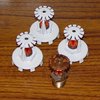LiveLife
Member
Most of my pistols have polymer parts that I wish to protect from potential house fire temperatures. And most of my reloading components (bullets, primers, powder and even brass) could be damaged by house fire heat that could reach 1700°F. While fire safes provide limited time protection from temperatures of a house fire, thought of inside fire safe reaching 350+°F is not comforting to me.
Then I came across a video of compound that supposedly mimics insulating qualities of "Starlite" developed by Maurice Ward in the 70s-80s to withstand laser heat of 10,000°C (18,032°F) - https://en.wikipedia.org/wiki/Starlite
Youtuber NightHawkInLight starts the video with a thin disk of his reproduction "Starlite" (Size and thickness of a corn tortilla) protecting his hand/fingers from the heat of a propane torch.
 I am curious whether 1/4" to 1/2" thickness of this material is enough to protect the contents (polymer pistol parts and reloading components) from the heat of house fire (Up to 1700°F).
I am curious whether 1/4" to 1/2" thickness of this material is enough to protect the contents (polymer pistol parts and reloading components) from the heat of house fire (Up to 1700°F).
At 3:20 minute mark of video, he shows the ingredients of corn starch, baking soda and white glue.
Then I came across a video of compound that supposedly mimics insulating qualities of "Starlite" developed by Maurice Ward in the 70s-80s to withstand laser heat of 10,000°C (18,032°F) - https://en.wikipedia.org/wiki/Starlite
Youtuber NightHawkInLight starts the video with a thin disk of his reproduction "Starlite" (Size and thickness of a corn tortilla) protecting his hand/fingers from the heat of a propane torch.
 I am curious whether 1/4" to 1/2" thickness of this material is enough to protect the contents (polymer pistol parts and reloading components) from the heat of house fire (Up to 1700°F).
I am curious whether 1/4" to 1/2" thickness of this material is enough to protect the contents (polymer pistol parts and reloading components) from the heat of house fire (Up to 1700°F).At 3:20 minute mark of video, he shows the ingredients of corn starch, baking soda and white glue.
Last edited:



